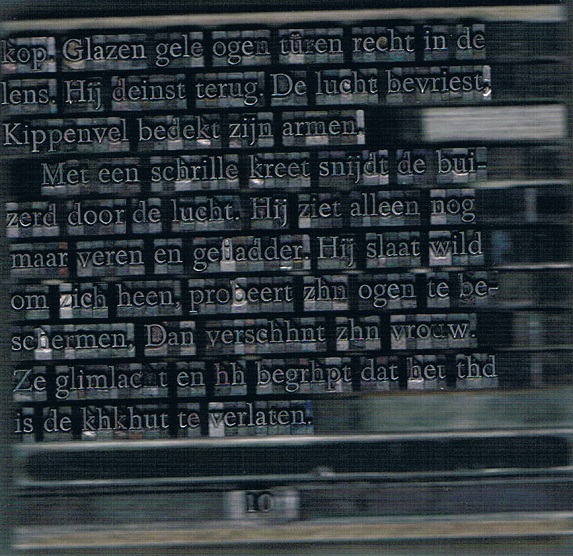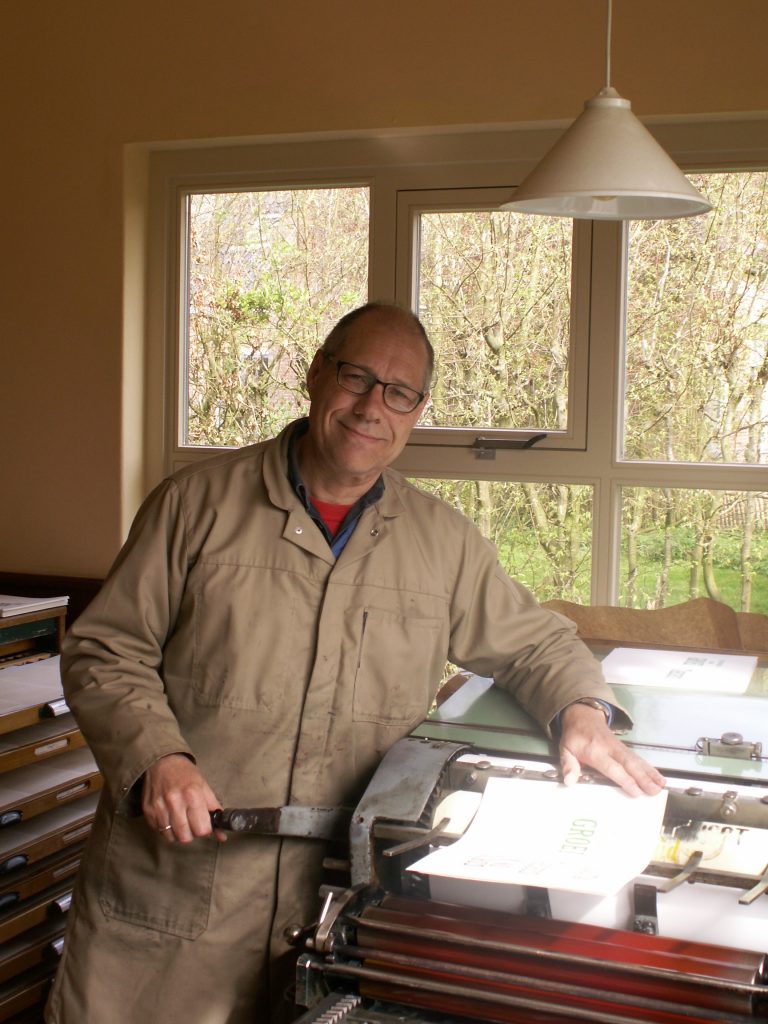‘De fotograaf en de buizerd’ heet mijn korte verhaal dat onlangs bij Triona Pers verscheen. Bijzonder aan het boekje is dat het met de hand werd gedrukt. Hoe doe je dat? Waar leer je zo’n oud ambacht? En valt met woorden te omschrijven wat een met de hand gedrukt boekje bijzonder maakt?
Ik vroeg dit en meer aan Dick Ronner, drukker en eigenaar van Triona Pers. Zijn antwoorden over een uitstervend ambacht fascineren.
Gepuzzel
Jij wilde ‘De fotograaf en de buizerd graag uitgeven, maar het verhaal mocht niet langer zijn dan ca. 600 woorden. Waarom was dat?
De hoeveelheid loden letters die ik heb is beperkt. Wanneer je een tekst van enkele bladzijden zet, dan is er een moment dat er één letter op is. Er is daar met wat kunstgrepen wel een mouw aan te passen, maar wanneer er twee of meer letters opraken dan wordt dat een heel gepuzzel.

Staafjes met letters
Hoe gaat het handmatig drukken van een boekje in z’n werk?
Allereerst kies ik de grootte van het boekje en – daarmee samenhangend – de zetbreedte. Dan beslis ik welke letter ik voor de tekst wil gebruiken. Vervolgens zet ik een stukje met de hand. Dat houdt in dat ik staafjes met letters in de goede volgorde in een zethaak zet.
Als er een zin klaar is, dan breng ik die over op een galei, een plaat met drie opstaande randen. Van het zetsel van een bladzijde maak ik een proefdruk. Als dat naar mijn zin is, dan zet ik nog enkele bladzijden. Vervolgens ga ik twee naast elkaar liggende bladzijden in oplage drukken. De vellen moeten een tijdje drogen, daarna kan ook de andere kant bedrukt worden.
Vaak maakt Flora de Jong, mijn vrouw, een linosnede bij de tekst. Het zijn eenvoudige afbeeldingen met daardoor juist een grote zeggingskracht.
Als alle vellen van een boekje gedrukt zijn, dan moet ik ze vouwen. De bladzijden schuif ik dan in de juiste volgorde in elkaar. Tenslotte moet ik de boekjes nog binden en op de juiste maat schoonsnijden.
Tijdrovend
Hoe lang ben je er ongeveer mee bezig?
Een boekje heeft meestal 12 of 16 bladzijden. Ik wissel het handwerk (zetten, drukken & binden) af met andere werkzaamheden. Ik geef namelijk ook lijviger boeken uit, die door andere bedrijven geprint of in offset gedrukt worden. Daarvan doe ik de digitale opmaak. Gemiddeld ben ik een maand bezig met een met de hand gemaakt boekje.
Waar heb jij het ambacht geleerd?
In januari 1991 begon ik met cursussen ambachtelijk drukken in het Grafisch Centrum in Groningen. Het duurde 24 cursusavonden voordat ik een dichtbundeltje af had plus een kerstkaart. Ik heb nog een aantal cursussen gevolgd, tot het moment dat ik zo ver was dat ik zelfstandig in de werkplaats kon gaan drukken.

In de tussentijd schafte ik mijn eerste materialen aan. Zo kon ik aan het eind van het jaar 2000 mijn eigen drukkerij in Houwerzijl (Noordoost-Groningen – OW) inrichten. Ik werk achterin het winkelpand waar we een antiquariaat begonnen.
Degelpersen
Kun je iets vertellen over de geschiedenis van de boekdrukkunst?
Johannes Gutenberg geldt als uitvinder van de boekdrukkunst. Hij was goudsmid en kwam bijna 600 jaar geleden op het idee om tekst uit gegoten losse loden letters te zetten. Voor die tijd werden tekst en afbeelding uit een houten plank gesneden. Het zetten ging met losse letters sneller, het corrigeren werd gemakkelijker. Na het drukken konden de letters gedistribueerd worden en zo opnieuw worden gebruikt. Het is bijzonder dat ik nog steeds op dezelfde manier tewerk ga bij het zetten als in de tijd van Johannes Gutenberg en Laurens Janszoon Coster.
In de eerste eeuwen werd gedrukt met degelpersen. Ik gebruik zelf een klein degeltje, een Adana. Daarmee kan ik op ansichtkaartformaat een stukje tekst drukken. Later werden er cilinderpersen ontwikkeld, zoals mijn Korrex proefpers.
Uitstervend
Toen de grafische sector in de jaren 70 van de vorige eeuw overging op fotozetten en offsetdruk is er veel materiaal verloren gegaan. Gelukkig zijn er ook veel bedrijven geweest die hun loden en houten letters en hun persen overdroegen aan liefhebbers van kleinschalig drukwerk.
Er zijn nauwelijks meer bedrijven waar met de hand gedrukt wordt, omdat het werk erg arbeidsintensief is en daardoor moeilijk kan concurreren met moderne druktechnieken. Kleine met zorg gemaakte uitgaafjes, zoals dichtbundels of een boekje met een kort verhaal, vinden wel hun weg naar liefhebbers. Dat geldt ook voor een bijzondere trouwkaart, een geboortekaartje, exlibris of visitekaartje.
Er zijn wel meer dan honderd particulieren in Nederland, die thuis of in een grafische werkplaats het ambacht af en toe beoefenen.
Levendigheid maakt het charmant
Waarin verschilt een met de hand gedrukt boekje volgens jou van een machinaal gedrukt boekje?
Loden letters druk je echt in het papier. Ik druk ook met oude houten letters, die vroeger voor affiches gebruikt werden. Vaak kun je voelen dat die in het papier geperst worden.
Ik werk met oud materiaal. De ene letter is wat meer afgesleten dan de andere, waardoor de tekst er niet zo strak uitziet als een tekst die geprint is of in offset is vervaardigd. Die levendigheid van het drukwerk maakt de tekst charmant.
